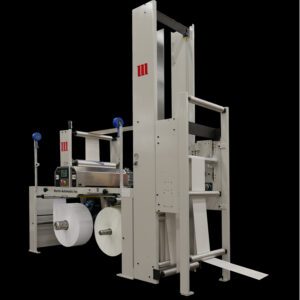Nick Coombes speaks with Gavin Rittmeyer of Martin Automatic about the company’s solutions to this perennial problem
NC: What are the basic issues that cause the problem?
GR: Printers and converters know that controlling tension in a web is essential to the quality of the finished product. Web tension problems can arise from several issues with the unwinding roll. These include deceleration, the action of splicing, and acceleration of a new roll. Out-of-round or unbalanced rolls also cause tension disturbances, even during steady state unwinding.
NC: How can these issues be countered?
GR: Machine designers need to consider the characteristics of the web, the weight of the roll, the mass of the system, and the capability of downstream equipment, often but not always a printing press. They also have to allow for the set tension and tension control requirements of the process, whatever it is. This can be done with a transducer or dancer system.
NC: How does the transducer system work?
GR: Typically, a transducer or load cell system relies on the principle of ‘sense and correct’. It uses a tension-sensing device, like a transducer roller and, through an appropriate control system, attempts to maintain the output of the sensor constant. This type of system has no ‘storage’, and its response-time limits its ability to adjust for rapid changes, so that tension transients are passed along to the process
NC: And the dancer system?
GR: This is our preferred way, with the dancer using the principle of inertia compensation that effectively absorbs tension upsets and delivers constant web tension to the process. This

method relies on the principle of ‘establish and maintain’. Tension is established by the dancer, and strictly proportional feedback from its travel is used to maintain the dancer within its stroke. Inertia compensation is achieved by engineering the system components to balance the translational (up and down dancer motion) and rotational (rotating dancer motion) inertias. So, unlike a typical load cell or transducer system, it actually ‘absorbs’ tension disturbances rather than passing them along to the process. The result is consistent web tension.
NC: This sounds like a simple principle of physics?
GR: It is, and it typifies Martin Automatic’s approach to engineering in that we never seek to complicate that which can be achieved simply using fundamental principles. Over the years, we have introduced inertia compensated tension control devices to the coating, printing, and converting industries, and made a major technical contribution in every case. The concept remains the simplest and most accurate means of delivering constant tension. On the market, and the principle is used for infeed and outfeed tension control systems, as well as Martin’s extensive line of unwinding and splicing systems.
NC: What makes it so special?
GR: Inertia compensation can be applied to any web and virtually all applications. It is especially beneficial in processes that involve lower tensile strength substrates, such as nonwovens and extensible films, where an inertia compensated dancer absorbs tension spikes that could otherwise lead to neck down or permanent deformation of the web. In these instances, customers can easily control tension to within +/- 0.25 pounds (1.1 Newtons) total variation, without the need for any complex control logic.
NC: What does the Martin solution entail?
GR: A Martin zero-speed splicer includes a festoon accumulator that not only supplies web to the process at full speed during the splice cycle, but also utilises inertia compensation to absorb tension upsets. When putting together splicer specifications, Martin engineers can select from several standard festoon configurations with different web storage and acceleration profiles. Depending on the application, some accumulators include a separate inertia compensated dancer to provide infeed-quality tension control to the process.
NC: Does this technology have to be part of the OEM installation?
GR: No, it doesn’t! And this is an important factor because Martin festoon and dancer systems are easy and economical to retrofit, providing a means of increasing the speed of existing processes and improving web handling of lighter or thinner materials. Once again, by using simple principles of physics, we have demonstrated how to improve productivity and become commercially more successful.












